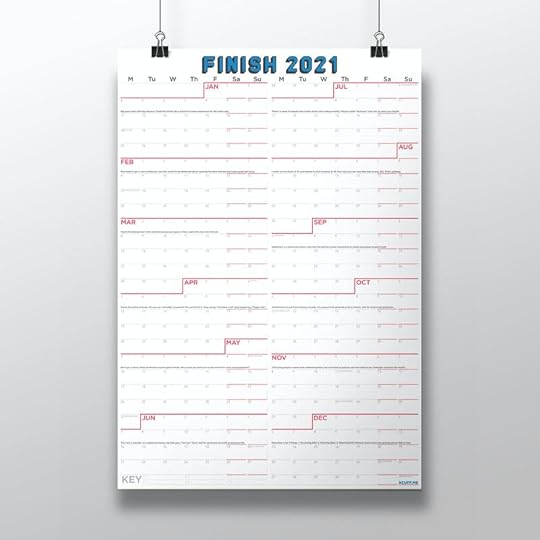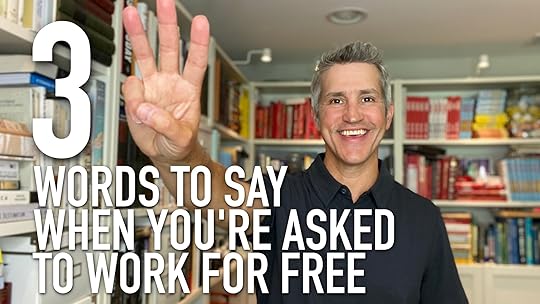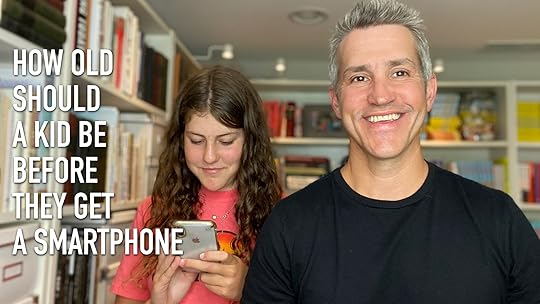Jon Acuff's Blog, page 26
September 1, 2020
7 ways to survive virtual school.
Congratulations on becoming a homeschooler!
What’s that you say?
You didn’t sign up to be a homeschooler?
You didn’t make that choice?
Ahh, don’t worry, 2020 made it for you.
This weirdo year keeps rolling out the surprises. Chances are, another surprise you’re about to face is virtual school. Didn’t see that one coming in January, did ya’?
We’ve been doing virtual school for three weeks at the Acuff house and I’ve learned a few things. More than a few, I’ve learned 7 things to be precise.
As I am wont to do these days, I made a video called, “7 ways to survive virtual school.”

If you have a kid who is about to Zoom the day away, this one is a must watch.
If you don’t have a kid, I bet you know someone who does. They are going to need this video. Forward it to them and just write, “Good luck.”
Click here to watch it.
Jon
The post 7 ways to survive virtual school. appeared first on Jon Acuff.
August 20, 2020
2021 is still going to happen, I promise.
The other day, someone asked me what I was thinking about and I said, “Christmas.”
They laughed, but I wasn’t joking.
In the middle of the weirdest year ever, I needed to be reminded that Christmas was still happening. That it was still a thing at the end of the year that would not be postponed, rescheduled or moved to March. The Mariah Carey train had already left the station and it was headed my way.
So has 2021.
That year is headed our way and it is going to be glorious.
I’m choosing to see it as the big, blank, wonderfully empty slate it is. The year 2020 will be in the rearview mirror, the election (for us Americans) will be over and we’ll have an entire new year to play with.
If there was ever a year where a big, physical reminder of that was necessary, it’s this one. I’ve never had such a sense of hope unrolling my new 2021 Finish Calendar like I’ve had this year. I’ve always used it as a productivity tool to plan my goals and my adventures, but this year is different.
This year, it’s a beacon of possibility. An empty canvas that I get to paint on all year long and I can’t wait.
Why is this the best calendar in the world? Let me count the ways.
It’s big. It’s 25” x 36” so you can see the whole year at once.
2. It’s designed to help you win the week. There aren’t any gaps between the months so that each week flows into the next like it does in real life.
3. It’s beautiful. Who wants to look at an ugly calendar all year?
4. It’s wicked functional. It comes in paper or dry erase to make sure you can use this tool exactly as you want to.
5. It’s encouraging. Each month comes with motivation from me.
2021 is headed your way. Greet it with a calendar that’s going to help you make the most of it. Click here to get one today.
Jon
The post 2021 is still going to happen, I promise. appeared first on Jon Acuff.
August 17, 2020
The 10 Worst Zoom Habits
Do you have a coworker who gives you vertigo because they insist on walking around their entire house while on a Zoom call?
Have you ever done a Zoom call with someone whose dog is barking like the hound of the Baskervilles but they refuse to acknowledge it?
Has staring at coworkers sitting in such poorly lit rooms that they look like terrorists making demands from a cave started to get old?
Fear not my friend, I have created a video that will fix all of that.
I’ve put together a list of the 10 worst zoom habits.
It’s funny enough that you can send it to all your friends, but helpful enough that they just might learn how to use the mute feature. (Has a button with one purpose ever been so misunderstood by so many people?)
If you need a laugh today and a check in to make sure you’re not doing any of these things, watch, “The 10 Worst Zoom Habits.”
Jon
P.S. Habit number 3 is the worst and I can’t believe people still do this.
The post The 10 Worst Zoom Habits appeared first on Jon Acuff.
August 10, 2020
How much money I made on YouTube in 30 days.
When I found out there were little kids making millions of dollars on YouTube opening boxes of toys, I immediately grounded my own kids.
I just didn’t realize how lazy they were being, you know?
Trust me, I know my kids. They have arms and hands and are capable of opening boxes. Just the other day I saw my oldest kid open a box of granola bars. For free. She just ripped it open, no cameras, no sponsors, no ad dollars. I was so disappointed.
YouTube is a weird world to me, but I am curious, can you make a living on YouTube?
That’s a question I’ve been exploring lately.
When the public speaking part of my business was put on pause, I did two things:
I started doing virtual events with clients.
I started exploring other opportunities.
YouTube is one of them.
I’ve been making a ton of videos and thought it might be fun to show you exactly how much money I made in 30 days.
Spoiler alert: The hourly rate I’ve made is going to surprise you.
If the pandemic is forcing you to pivot or you’re just curious how much money is out there on YouTube, don’t miss this one.
Click here to watch the video.
Jon
P.S. Did you know I have a new YouTube channel? You should subscribe.
The post How much money I made on YouTube in 30 days. appeared first on Jon Acuff.
August 3, 2020
Be brave enough to be bad at something new.
I’m terrible at hang gliding.
I’m the worst at spear fishing.
I’m very mediocre at managing the harbor traffic in Savannah. (The title “Harbor Master” intrigues me, but the “not crashing boats into one another part” is where I would probably get fired.)
How do I know all of these things?
Because I’ve never done any of them. That’s one of the simple rules of life that I think we can all agree on. You will be bad at things you’ve never done.
But though we know that in our heads, I’m often shocked at how often we don’t really live that out in our lives. There’s a great temptation to beat yourself up when you start doing something new and it doesn’t instantly go well.
In ordinary days, that habit of demanding instant success from new things is a bit of an annoyance. But right now? It’s toxic.
Why? Because this is a huge, crazy season of new.
None of my friends has been through a global pandemic, election year and looming recession before. I don’t know a single person right now that’s saying, “It’s cool, this is my fifth deadly virus pandemic and I’m an expert at these.”
We’re all neck deep in doing new things and pivoting and changing our jobs and ahhhh, when will our kids go back to school?
Do you know what you need right now? Do you know what mindset will save you gobs of frustration? Do you know what approach will give you freedom to learn without judgment?
You need to be brave enough to be bad at something new. Or, said with a smidge more aggression, “Don’t be afraid to suck at something new.”
What do I mean by that?
This.
I made a short video explaining what it takes to do something new without judging yourself so quickly that you quit before you’ve had the opportunity to get better.
The video has a brief stingray story, someone close to me telling me my other videos were boring and some dry cleaning in the background for ambiance. Obviously it has those three things.
If you’re feeling a bit overwhelmed by all the new that’s being thrown at you right now, watch this.
Jon
P.S. Did you know I have a new YouTube channel? You should subscribe.
The post Be brave enough to be bad at something new. appeared first on Jon Acuff.
July 27, 2020
5 encouraging books for discouraging times.
Right now, I feel like my thoughts fluctuate between two different positions:
Things will go back to normal soon. Everything is going to be fine. There’s great opportunity hidden in the midst of uncertainty. You can do this!
Things will never be normal. Everything is terrible. Will the clothing store I worked at in high school, Maurice the Pants Man, rehire me? You can’t do this!
The cool thing is that some days, I have both of those thoughts in the same exact hour if not the same exact minute.
This is the weirdest season ever. I just keep saying that word over and over again. Weird. This is weird. How weird.
Fortunately, I wrote a book about overthinking and learned an awful lot about changing my thoughts. I can’t wait for you to read it. It comes out in April and I think it’s going to help a ton of people who feel like they’re overthinking everything.
Until then though, what are other books that might be encouraging during these discouraging times?
Well today, I’ll tell you my personal list of 5 encouraging books for discouraging times:
“The Boy, the Mole, the Fox and the Horse” written and illustrated by Charlie Mackesy.
I loved what Elizabeth Gilbert of “Eat, Pray, Love” fame said about this book. She wrote, “The world that I am required to inhabit is this one. But the world that I long to inhabit is the one that Charlie Mackesy has created.” That’s what this is. It’s a beautiful, inspiring world where a boy goes on an adventure with a few friends. It reminds me a little bit of Winnie the Pooh, in that it sneaks up on you with deep wisdom. When I looked it up on Amazon, I was blown away to see that it has 23,000 reviews! There’s a good chance you’ve already seen this one, but if you haven’t, give it a look.
2. “This is Water: Some Thoughts, Delivered on a Significant Occasion, about Living a Compassionate Life” written by David Foster Wallace.
David Foster Wallace’s life came to a tragic end in 2008, but this book is one of the most hopeful things I’ve ever read. It’s not long. It’s actually the commencement address he gave in 2005 at Kenyon College. It’s about freedom and attention and what we all get to choose to focus our lives on. It’s a book that I need to reread at least once a year, especially when I get obsessed with my own needs, my own fears and my own kingdom.
3. “Positivity: Discover the Upward Spiral that Will Change Your Life” written by Barbara L. Fredrickson, PhD.
This is the most scientific book on the list but don’t let that fool you, this is highly readable and highly practical. Dr. Fredrickson is a professor of Psychology and Neuroscience at the University of North Carolina at Chapel Hill. I quoted her in my new book because she’s one of the leading scholars on the subject of positivity and I wanted to go beyond all the motivational clichés you often see about this topic. My favorite part of this book, which I won’t spoil for you here, is her positivity ratio. If you want a non-fiction, no nonsense read on positivity, this is the one.
4. “Rules of the Red Rubber Ball” written by Kevin Carroll.
I saw Kevin speak live more than a decade ago and bought this book immediately. Have you ever done that? Maybe you saw a TED talk online or went to an event and really connected with the speaker? That was Carroll for me. He has an infectious spirit and outlook on life. He’s worked with the NHL, ESPN, Nike, and Starbucks. His words have actually appeared on 17 million Grande cups. That’s a fun fact. This is one of those small, powerful books packed with hope. I love the design, too. Each pages feels like a chance to explore something new.
5. “What do you do with a problem?” written by Kobi Yamada and illustrated by Mae Besom.
Another children’s book? Do you see a theme here? When I’m feeling discouraged, I want something colorful, creative and simple. If you’ve got a 600-page book about encouragement, just lifting that thing is going to bum me out. Books like this on the other hand are paper serotonin. I first discovered Yamada’s work when I read, “What Do You Do With An Idea?” I loved that book and was excited to discover this second one. The illustrations are ridiculous. I hope Mae Besom has a long, massive career because her stuff is gorgeous. Again, it’s one of those books that’s for kids but is actually for adults, too.
Those are five books that I find really encouraging and I tried to pick a variety across a couple of different genres.
These are weird times.
They are, but sometimes all you need to pick up your spirits is a new book.
I’ve included all the links to the books so that you can go check them out for yourself. They are affiliate links of course, because babies need shoes!
I hope you enjoy those books as much as I do.
Jon
P.S. Want to see the 5 books that changed my life? Watch this!
P.P.S. Bonus book! The Genesee Diary: Report from a Trappist Monastery by Henri Nouwen has been kicking my butt this summer.
The post 5 encouraging books for discouraging times. appeared first on Jon Acuff.
July 20, 2020
3 words to say to someone who asks you to work for free.
If you’re a photographer, designer, developer, writer, freelancer or human, someone is going to ask you to work for free.
They might ask for a favor.
They might say you’ll get exposure.
They might even try to guilt you into turning your “no” into a “yes.”
What do you do in that moment? What if it’s a friend, family member or neighbor?
It took me years, but I finally figured out 3 words that completely diffuse the situation.
Not only do these words diffuse things, they often end up making you a lot of money in the process.
I made a quick video explaining the technique I use. It’s Velcro easy. (I think that’s going to be my new phrase to describe things that are ridiculously easy. I’m also trying to bring the word “mint” back from the 1980s. “This video is mint!”)
If you’re tired of being asked to do free projects, watch this.
Jon
P.S. Did you know I have a new YouTube channel? You should subscribe.
The post 3 words to say to someone who asks you to work for free. appeared first on Jon Acuff.
July 13, 2020
How old should a kid be before they get a smartphone?
I used to think my oldest daughter wouldn’t get a smartphone until she was about 25 years old.
I imagined making a toast at her rehearsal dinner and saying, “I’m so excited about this wedding and I’ve got one more surprise! Sweetheart, here’s your first smartphone!”
I exaggerate a smidge, as I am wont to do, but I did have a closeminded attitude when it came to my kids and smartphones.
What changed? Well, I explain it in this quick video I made.
If you have a kid, regardless of the age, I think this video will really encourage you.
We’re the first generation of parents who have ever needed to deal with smartphones.
It can be challenging, but it can also be a lot of fun.
Click here to watch the video.
Jon
P.S. Did you know I have a new YouTube channel? You should subscribe.
The post How old should a kid be before they get a smartphone? appeared first on Jon Acuff.
July 6, 2020
5 legit reasons your spouse isn’t supporting your dream.

Marriage math is crazy. When two people are pushing in the same direction on a dream, 1 + 1 doesn’t equal 2. It equals approximately 19 million. What two people can get done together is exponentially bigger than two people who are at odds. Jenny and I have spent the last 12 years with our arms linked on a series of side hustles, projects and adventures.But wait, haven’t we been married for 19 years?
We have, but it took us a bit to figure out how to really support each other.
If you’re married and working on a dream, I made a video you need to watch.
In it, I quickly cover the 5 legit reasons your spouse is not supporting your dream.
Save yourself a few years of frustration and figure out how to dream together.
Click here to watch.
Jon
P.S. I’m going all in on YouTube and would love if you subscribed to my new channel.
The post 5 legit reasons your spouse isn’t supporting your dream. appeared first on Jon Acuff.
June 29, 2020
How to fall asleep when you’re stressed out.
Have you had a hard time falling asleep lately?
That’s weird, I haven’t.
I’ve had such peaceful, global pandemic sleep. My head hits the pillow and I enjoy eight, stress free hours of slumbertown.
Or, I toss and turn, while trying to figure out what disastrous thing the news is going to tell me about tomorrow and what I’m possibly supposed to do about murder hornets.
One of those two scenarios happened a lot, especially during the first 8 weeks of the pandemic.
But then, I learned a trick that’s helped me a lot.
I started saying a simple sentence to my stress each night.
I made a quick video that walks you through exactly what I do.
The next time stress wakes you up at 3AM I want you to be ready.
Click here to watch the video.
Jon
P.S. Did you know I have a new YouTube channel? You should subscribe.
The post How to fall asleep when you’re stressed out. appeared first on Jon Acuff.










